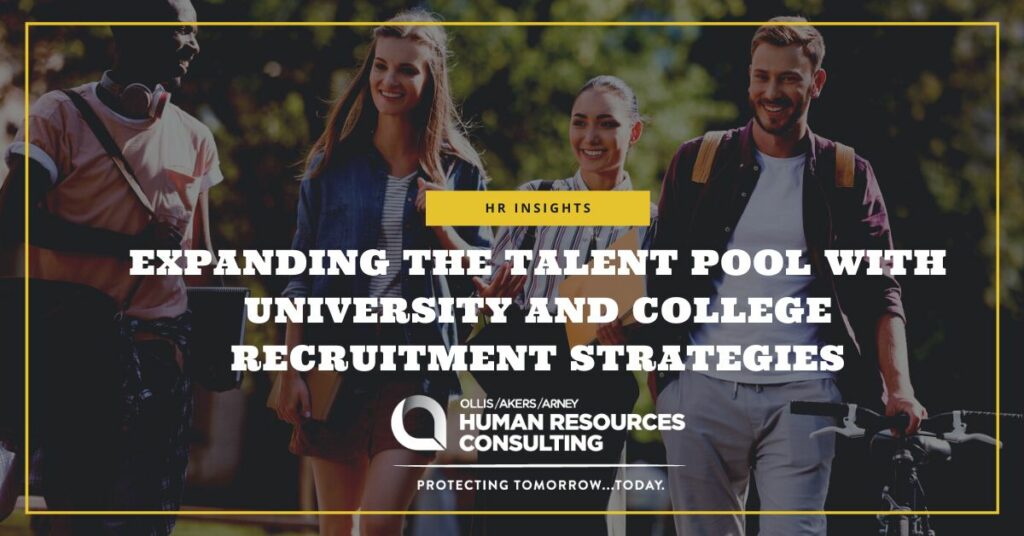A common misstep in attracting or recruiting talent is setting narrow restrictions on who to interview or where talent is sourced. Often, highly talented job candidates are overlooked due to inexperience. Employers have an opportunity to expand their recruiting reach by pursuing entry-level candidates at universities, colleges and trade schools, but it comes down to hiring for skills or the right fit—rather than experience—and offering training and career development on the job. This kind of strategy is considered a core recruitment function for many organizations.
As new generations enter the workforce and everyday job skills change, savvy employers can secure candidates who have the potential to grow in a new career. This article explores the opportunity for recruiting and hiring employees from universities, colleges and trade schools and ways to build a sustainable recruitment strategy.
Types of Institutions and Skills
Understanding the various learning institutions employers partner with and their differences is essential to determine which will be more beneficial for employers to recruit from. A university generally refers to a larger higher education institution that offers both undergraduate and graduate programs. They often have an emphasis on conducting research.
On the other hand, a college is often smaller and usually refers to community colleges, technical schools and liberal arts colleges. They typically only focus on undergraduate studies. A trade or vocational school offers programs that can be completed within one or two years and focus on a career-intensive curriculum with hands-on experience.
Just as there are various learning institutions, there are different skill sets employers may want to seek out depending on their industry or organization. In some cases, many may desire workers with an undergraduate degree or master’s degree; other companies may be interested in trade talent or specialized skills.
The Opportunity and Benefits
The opportunity to build a continual talent pipeline is there and will remain. The U.S. Bureau of Labor Statistics reported the following about graduates (ages 20 to 29) in 2021:
- 1.3 million earned a bachelor’s degree.
- 371,000 completed an associate degree.
Keep in mind that these statistics don’t include other age ranges, many of whom could be graduates—and great potential employees.
Educational institutions have been providing employers with high-quality talent for a long time. Still, there are reasons to amp up those efforts and explore additional ways to throw a wider net for entry-level candidates.
Consider the following benefits of targeting and hiring candidates via universities, colleges and trade schools or from different sectors or even roles:
- Continuous supply of candidates—Universities and colleges offer talent continually; multiple groups of students graduate in a given year. As such, employers can connect with new graduates several times throughout the year.
- Fresh, transferrable skills—It can be beneficial to hire someone with solid communication, leadership, teamwork and problem-solving skills instead of focusing on years of industry experience. This is because employers can offer learning and development opportunities to help such employees learn about the industry, department or role. For example, some liberal arts colleges may focus heavily on writing and thinking skills, which apply to many positions and may not necessarily be able to be taught in the workplace.
- Increased innovation—A candidate outside your sector won’t have industry fatigue and is positioned to bring fresh ideas to the workplace. Employees new to an industry tend to be more adaptable and open to new ways of working. This fresh perspective can push organizations out of their comfort zones and help them consider innovative or competitive approaches. Universities and colleges generally stay up to date, so students are poised to bring in the freshest ideas and forward-thinking perspectives.
- Improved employer branding—Organizations can build a renewed perception of their employer brand by building their brand within university and college settings. Campus recruitment is a great way to reach a wider audience for the organization’s brand.
- Diverse talent pool—Hiring candidates from various universities and schools can help an organization expand its candidate reach and find potential employees of varying backgrounds.
While experience and industry knowledge have their places in recruitment and hiring, it can be beneficial for organizations to hire talent from outside their industry or consider candidates with the right skills but not enough experience yet.
University and College Recruitment Strategies
Employers looking to expand their recruiting reach should review the following considerations to sustainably engage candidates in a learning environment:
- Attend in-person events. Especially before the pandemic, many university recruiting strategies relied on visiting select campuses to recruit entry-level candidates. This is still a successful strategy for employers to engage and connect with candidates on campus. Most universities and colleges hold in-person career fairs.
- Actively recruit virtually. An organization hiring remote or hybrid workers can leverage online platforms to engage with candidates and bolster their company’s brand. But it takes more than simply establishing online accounts; employers should be proactive and promote that they are open to hiring outside candidates since they offer learning and training opportunities. Additionally, online portals (e.g., Handshake) can help employers connect with students where they are and start personalized recruiting conversations.
- Participate in virtual recruiting efforts. Many universities have integrated virtual learning, and using that same approach for entry-level recruiting is effective. Virtual recruiting is an efficient way to broaden and diversify the recruitment reach for college students. Virtual career fairs will likely be hosted by colleges, trade associations or other organizations. Alternatively, a virtual event or webinar may be focused on a particular industry, profession, experience or geographic area, which can help recruit mid-level and senior positions or other nonuniversity candidates.
- Build relationships with stakeholders. For a partnership to succeed or be impactful, employers must develop long-term relationships with institutional stakeholders, such as career centers and professors. Employers may find through a quick phone call or email that career centers, for example, will be very receptive to learning more about an employer’s opportunities and establishing a relationship.
- Establish an internship or apprenticeship program. Such programs can be a strategic way to get talent in the door early and provide candidates with real-life experience. Ultimately, employers will also know if candidates have the necessary skills and if they are a good match for the company culture. Candidates may also be more likely to select a full-time employer they’ve already worked for in a less permanent capacity. An internship or apprenticeship program allows an organization to show off its workplace culture and career opportunities to rising top talent.
- Offer learning and development opportunities. Regardless of industry or age, today’s workers want career growth opportunities. Learning and development opportunities can help employees become better at their jobs and overcome performance gaps due to a lack of access to knowledge or skills. Remember that training only fills a gap, whereas professional development focuses on long-term employee and company growth.
Recruiting from higher education institutions relies on establishing effective relationships with educational institutions and identifying and engaging with suitable candidates that can bring value to the workplace and grow in a career there. Recruitment can be a mutually beneficial opportunity for both employers and universities.
Summary
Suppose employers are having a hard time finding qualified candidates. In that case, they could consider expanding their recruitment reach by pursuing entry-level workers from universities and other types of higher education institutions. New energy and fresh perspectives from recent and soon-to-be graduates can help organizations innovate and develop a strong workplace culture.
Contact Ollis/Akers/Arney Human Resources Consulting today for more information and help finding ideal candidates for your company.
This HR Insights is not intended to be exhaustive nor should any discussion or opinions be construed as professional advice. © 2022 Zywave, Inc. All rights reserved.






